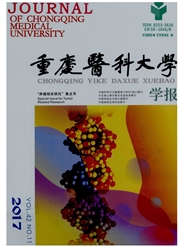

 中文摘要:
中文摘要:
目的:探讨c-raf-1基因反义寡核苷酸转染对人卵巢癌SKOV,细胞增殖的抑制作用及其分子机制。方法:实验分3组:正常对照组、c-raf-1正义治疗组、c-raf-1反义治疗组。脂质体转染后不同时间分别进行MTT试验、集落形成试验、荧光显微镜检测、蛋白质荧光强度测定,以观察不同条件处理后各组细胞的增殖、凋亡、蛋白质表达有无差别。结果:反义治疗组与正义治疗组比较:转染72h OD值分别0.272与1.307(P〈0.05);克隆形成率分别为30.6%与75.0%(P〈0.05);凋亡率分别为19.7%与9.2%(P〈0.05),同时明显地下调P74蛋白质的表达水平(P〈0.05)。结论:c-raf-1反义寡核苷酸对人卵巢癌SKOV,细胞的增殖有明显的抑制作用。
 英文摘要:
英文摘要:
Objective: To investigate the effects and the mechanisms of c-raf-1 genes antisense oligodeoxynucleotides ( ASODN ) transfection in inhibiting the human ovarian carcinoma SKOV3 cell lines. Methods: There were 3 groups in our study: normal control group, c-raf-1 sense oligodeoxynucleotides ( SODN ) experimental group, and c-raf-1 antisense experimental group, at the different time points after liposome-mediated transfection, the cell proliferation, apoptosis, protein expressing level were observed by MTT assay, flow cytometry, fluorescent microscope and cloning test. Results: In the ASODN experimental group and SODN group, the OD-value were 0.272 and 1.307 respectively ( P〈0.05 ) 72h after transfection; the cloning efficiency were 30.6% and 75.0% respectively ( P〈0.05 ) ; the apoptosis rate were 19.7% and 9.2% respectively ( P〈0.05 ) and the level of P74 protein was decreased statistically in c-raf-1 ASODN group. Conclusions: The proliferation of the human ovarian carcinoma SKOV3 cell lines can be inhibited by the c-raf-1 ASODN.
 同期刊论文项目
同期刊论文项目
 同项目期刊论文
同项目期刊论文
 期刊信息
期刊信息
